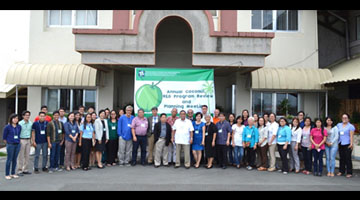 LOS BAÑOS, LAGUNA – With such economic importance of coconut as an agricultural commodity, DOST’s Philippine Council for Agriculture, Aquatic and Natural Resources Research and Development (PCAARRD) included coconut as a priority commodity under its Industry Strategic S&T Plan (ISP). The initiative seeks to improve national productivity through increasing nut yield by 226% in 2020.
LOS BAÑOS, LAGUNA – With such economic importance of coconut as an agricultural commodity, DOST’s Philippine Council for Agriculture, Aquatic and Natural Resources Research and Development (PCAARRD) included coconut as a priority commodity under its Industry Strategic S&T Plan (ISP). The initiative seeks to improve national productivity through increasing nut yield by 226% in 2020.
In support of this goal, 67 researchers from different agencies convened to evaluate the status and accomplishments of the coconut projects during the Annual Coconut Program Review and Planning Meeting held at the PCAARRD Headquarters, Los Baños, Laguna.
Among the topics discussed were coconut genomics, enhancement of coconut R&D and S&T-based control strategies against “cocolisap”.
The participants led by PCAARRD Executive Director Patricio S. Faylon (middle-left) during the Annual Coconut R&D Program Review and Planning Meeting.
Coconut genomics program for productivity
One of the programs reviewed during the meeting was the Improvement of coconut varieties through genomics, genetics, and molecular breeding for a competitive and sustainable Philippine coconut industry. The program focuses on increasing coconut productivity through genomics-assisted marker-selection for major industrial traits and molecular breeding.
Implemented by the University of the Philippines (UP), the program has four projects, all of which aim to generate molecular markers associated with important traits such as high nut and copra yield, early flowering time, fast growth, good water quality, and oil biosynthesis and mutations in the coconut endosperm.
The gene markers generated will be used for coconut varietal development with focus on high nut and copra yield, high oil content, and resistance to insect pests. The project also develops a genetically modified corn expressing coconut genes associated with oil biosynthesis.
The project team has already started identifying, isolating, cloning and characterizing genes involved in oil biosynthesis.
The major expected outputs of the project are dissemination of outstanding tall coconut varieties, nationwide replanting of genuine Philippine Coconut Authority (PCA) hybrid seed nuts, and development of composite/synthetic coconut varieties for regional dissemination.
The project also focuses on constructing a web-based breeding resource and developing molecular markers targeting glandular trichomes and resistance to scale insect.
Enhancing coconut R&D
The second major program under the Coconut ISP is the Integrated coconut Research and Development Enhancement Program (ICREDEP). The program integrates R&D efforts on the conservation and utilization of coconut genetic resources, farm productivity, diversification, and contribution to climate change. Primarily, the program seeks to create economic, ecological and social impacts to the industry’s stakeholders. PCA leads the program which is now on its third year.
ICREDEP has five projects which mainly focus on three research areas: genetics resources utilization, production systems improvement, and increasing farmers’ income.
The project aims to use coconut genetic resources for high value and emerging products such as coco sap sugar, galactomannan, and virgin coconut oil (VCO). It also focuses on characterizing and conserving coconut genetic resources for use in the Bicol region and nearby coastal areas.
Twenty-three out of 24 farms with optimum nut yield potential may be considered as local sources of well adapted planting materials in support of the Cadang-cadang disease management program. The project also evaluated the soil organic matter (SOM) levels in selected coconut ecosystems with emphasis on carbon sequestration and integrated soil fertility management.
In addition, the development and promotion of an Integrated Pest Management (IPM) against the invasive Brontispa longissima (Gestro) was also established. Among the significant accomplishments presented is the use of parasitoid called Tetrastichus sp. as biological control and the massive IPM awareness campaign in Brontispa infested areas nationwide.
The project also helps the coconut industry stakeholders in Oriental Mindoro and Albay by developing income generating schemes. Five community-based organizations (CBOs) were trained and supported in adopting farming technologies such as establishment of community-based coconut nursery, intercropping, livestock integration, and production of coconut high value and novel products.
The team reported that 12,000 high yielding and early bearing nuts were provided to the project sites which resulted in expansion of coconut areas by 23.88 ha. Several processing equipment were also provided to the members of the CBOs to help increase their income. Likewise, trainings on different processing techniques were conducted.
S&T-based control against the coconut scale insect (CSI) or “cocolisap”
In a recent survey, an accelerated rate of spread of cocolisap was observed particularly in Quezon. The long distance jump dispersal can be attributed to transport of infested planting material and wind dispersal. The team recommended an intensified control and quarantine measures in the outskirts of cocolisap-infested areas to prevent spread to Bicol Region and other major coconut growing areas.
As for the assessment of infestation in CALABARZON after typhoon “Glenda”, it was reported that the pest population and level of infestation severity decreased in some areas where infestation level is moderate. However, the typhoon has no significant impact on infestation as the pest is confined mostly in the peripherals of the leaf midrib. It is expected that by 2015, the infestation will significantly decrease through S&T-based approaches.
